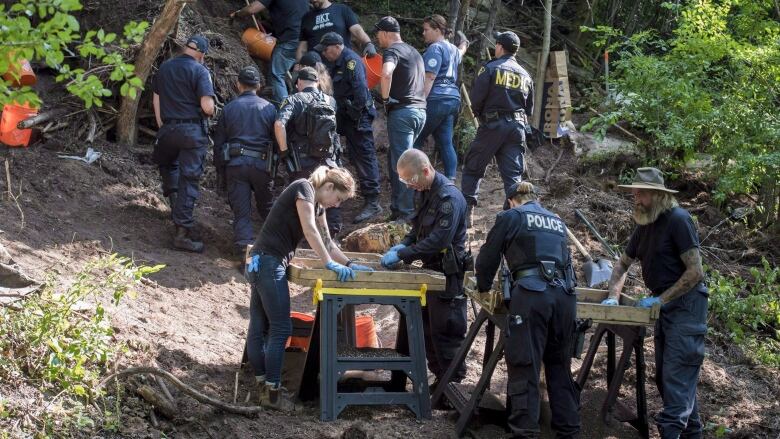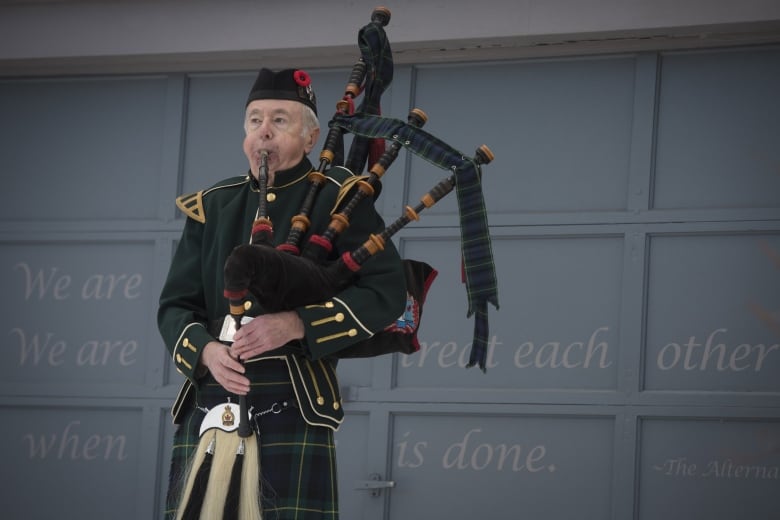'This is still very raw': One year since arrest of accused serial killer Bruce McArthur
On Jan. 18, 2018, police announced Toronto landscaper had been charged with 1st degree murder

On Friday morning, snow covered the ground outside the Toronto home of Karen Fraser and Ron Smith as the sounds of bag pipes from a lone piper wafted through the cold air, a tribute to the eight men whose remains were found around their property.
On Jan. 18 last year, police announced they had arrested landscaper Bruce McArthur for the murders of men who went missing from Toronto's gay village. At that time, police also knocked on the homeowners' door.
'Remember the good men lost'
On Friday, it was Fraser's idea to enlist a bagpiper, a way to mark the anniversary in a simple way.
"We're just here to remember. To remember the good men lost," said Rev. Deana Dudley of the Metropolitan Community Church. "It's been a year, and it's still fresh in people's minds. For some folks, this is still very raw. I expect we'll still be feeling a little raw on the tenth anniversary."

Also at the Mallory Cresc. property to pay his respects was Toronto Police Insp. Hank Idsinga, the lead investigator on the case.
Last year, Idsinga become the face of this investigation, a case that would draw international attention.
It also sparked some anger from the LGBT community who felt that police initially may not have put sufficient resources into finding the culprit.
"There's a lot of work that's been done, there's still a lot of work to do," Idsinga said Friday. "On a personal level, I've developed some new and very good relationships with members of the community ... hopefully we can resolve any of the further issues down the road."
It was at police headquarters last year on Jan. 18 that Idsinga would tell reporters that, just a day earlier, there had been significant progress in Project Prism — a police task force struck to probe the disappearances of Andrew Kinsman, 49, and Selim Esen, 44, in 2017.
That morning, he announced police had arrested 66-year-old Bruce McArthur of Toronto; he was charged with first-degree murder in the deaths of Kinsman and Esen.
CBC Toronto would later learn that on that same morning, police, who had been observing McArthur, saw a man enter his residence. The officers, who believed the man to be in imminent danger, forcibly entered McArthur's apartment. Inside, police found a man in restraints, sources told CBC.
Deaths of other men
Along with announcing the two murder charges, Idsinga would also reveal that investigators believed McArthur was responsible for the deaths of other men who had not been identified.
In other words, McArthur was an alleged serial killer.
Since his arrest, he has been charged with the murder of six other men: Skandaraj Navaratnam, 40, Abdulbasir Faizi, 44, Kirushna Kumar Kanagaratnam, 37, Dean Lisowick, 47, Soroush Mahmudi, 50, and Majeed Kayhan, 58. Of the eight victims, seven had ties to the LGBT community in Toronto.

His trial date has been set for Jan. 6, 2020. The trial is expected to take three to four months.
That McArthur will be tried nearly two years after his arrest may seem like an unusually long delay. But investigators have collected mounds of evidence, including human remains, DNA, and computer files.
From McArthur's apartment alone, police said they collected more than 1,800 pieces of evidence, along with 18,000 photographs, in what they described as the "largest forensic examination" in the force's history.
"All of that information has to be coordinated and reviewed and then put together in a forum with everything else for the defence lawyers ... it can be daunting," said B.C. criminal lawyer Marilyn Sandford, part of the legal team to represent serial killer Robert Pickton. "It can be time consuming."
As the case has made its way through the legal system, McArthur has made several court appearances, including some through video link from the Toronto South Detention Centre in Etobicoke, Ont.
Thinner, head shaved
In court, McArthur rarely shows emotion. He appears thinner with his head shaved and no longer sports a goatee. It's a much different look than the one portrayed in his Facebook pictures that were splashed throughout the media, showing a smiling man, posing in front of Niagara Falls.
While many details have not yet been released, including the cause of death of the victims, much about the investigation has been revealed through court documents.

By mid-August 2017, six weeks after Kinsman was reported missing, court documents showed McArthur was identified as a person of interest in the case. About a month later, detectives had applied for tracking warrants for two vehicles registered to him.
In November 2017, police were using GPS devices to track his daily movements. On Dec. 5, 2018, police applied for a warrant to covertly enter McArthur's apartment to clone and analyze multiple hard drives located in his bedroom. But they had to cut their task short when it was learned McArthur was on his way back.
Investigation questions
As new information came to light, questions were raised about how the investigation had been handled. For example, CBC Toronto learned that police had interviewed McArthur years before he was arrested. That knowledge prompted the Toronto police professional standards unit to launch an internal investigation into the matter.
Meanwhile, the force has been criticized for dismissing the LGBT community's concerns about a possible serial killer , and for its approach to missing persons cases, particularly those involving people from marginalized communities.
"I think this really threw a spotlight onto a lot of the issues the community has faced with policing. It blew the doors wide-open," said Will Griffiths, a resident of Toronto's Gay Village.

The Alliance for South Asian AIDS Prevention had also called for a review into whether race or the perceived sexuality of the missing men affected the resources and quality of the investigation into their disappearances.
In the wake of those criticisms, an independent review was launched into how Toronto police handles missing persons cases.
Missing persons unit launched
Toronto police launched its first missing persons unit in July, 2018. It has reviewed thousands of missing persons cases from across the city
Idsinga acknowledged that it's "still a work in progress."
Haran Vijayanathan, executive director of the Alliance for South Asian AIDS Prevention, who is on the missing person's independent review committee, said some good has come out of such a tragedy.
"The police chief has a missing persons unit now, which is great," he said.
International attention stemming from the McArthur case is "putting pressure on politicians and police officers and community organizations" to take a closer look at "what safety means for marginalized communities," he said.
With files from Melissa Mancini, Jacqueline Hansen, and Ioanna Roumeliotis

